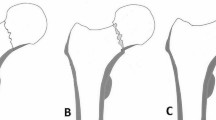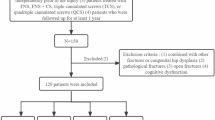Abstract
Background
Femoral neck fractures (FNF) are becoming increasingly common as population ages. Nondisplaced fractures are commonly treated by cancellous, parallel placed, partially threaded cannulated screws (PTS). This allows controlled fracture impaction. However, sliding implants can lead to femoral neck shortening (FNS) that has been shown to be correlated with reduced quality of life and impaired gait pattern. Recently, in our institution we have changed the fixation of FNF to fully threaded screws (FTS) with or without an additional partially threaded screw in order to minimize this phenomenon. The aim of this study was to compare the FNS in patients treated with FTS as compared with our historical controls treated with PTS.
Patients and methods
Between 2014 and 2016, 38 patients with FNF were treated with FTS. Out of the 38, 24 were available for radiographic follow-up. 41 patients treated previously with PTS were available as a control group. Radiographic analysis was performed to assess the FNF in three vectors: Horizontal (X), Vertical (Y) and overall (Z) according to the neck-shaft angle.
Results
Time for admission to surgery was longer in the PTS group (p = 0.04). Patient demographics and major complication rates were similar in the two patient groups. Average FNS in the X axis was significantly smaller in the FTS group than in the PTS group (2.8 ± 3.6 vs 7.6 ± 4.2 mm, p < 0.01) as well as the Y axis (1.2 ± 2.6 vs 4.9 ± 4.2 mm, p < 0.01) and thus also decreased overall Z shortening (2.3 ± 3.5 vs 6.23 ± 4.5 mm, p < 0.01). There was a tendency towards a more valgus reduction in the PTS (137° vs 134°, p = 0.08). There was a significantly smaller number of FTS patients with moderate (5–10 mm) or severe (> 10 mm) FNS. Screw pull-out > 5 mm occurred in 17/41 patients in the PTS but none in the FTS group (p < 0.01).
Conclusion
This study proves that use of FTS improves the radiographic results following FNF fixation using cannulated screws.



Similar content being viewed by others
References
Cummings SR, Melton LJ (2002) Epidemiology and outcomes of osteoporotic fractures. Lancet 359(9319):1761–1767
Svedbom A et al (2014) Epidemiology and economic burden of osteoporosis in Switzerland. Arch Osteoporos 9:187
Cooper C, Campion G, Melton LJ 3rd (1992) Hip fractures in the elderly: a world-wide projection. Osteoporos Int 2(6):285–289
Asnis SE, Wanek-Sgaglione L (1994) Intracapsular fractures of the femoral neck. Results of cannulated screw fixation. J Bone Jt Surg Am 76(12):1793–1803
Parker MJ et al (1991) Intracapsular fractures of the neck of femur. Parallel or crossed garden screws? J Bone Jt Surg Br 73(5):826–827
Weil YA et al (2012) Femoral neck shortening and varus collapse after navigated fixation of intracapsular femoral neck fractures. J Orthop Trauma 26(1):19–23
Zlowodzki M et al (2008) Femoral neck shortening after fracture fixation with multiple cancellous screws: incidence and effect on function. J Trauma 64(1):163–169
Zielinski SM et al (2013) Femoral neck shortening after internal fixation of a femoral neck fracture. Orthopedics 36(7):e849-58
Liu Y et al (2013) Femoral neck shortening after internal fixation. Acta Orthop Traumatol Turc 47(6):400–404
Boraiah S et al (2010) Predictable healing of femoral neck fractures treated with intraoperative compression and length-stable implants. J Trauma 69(1):142–147
Karanicolas PJ et al (2009) Interobserver reliability of classification systems to rate the quality of femoral neck fracture reduction. J Orthop Trauma 23(6):408–412
Liebergall M et al (2006) Computerized navigation for the internal fixation of femoral neck fractures. J Bone Jt Surg Am 88(8):1748–1754
Kara A et al (2016) Procedural outcomes of double vs. single fluoroscopy for fixing intertrochanteric femur fractures. Arch Orthop Trauma Surg 136(7):929–934
Paley D (2002) Principles of deformity correctiob, 1st edn. Springer, Berlin, p 803
Slobogean GP et al (2017) Femoral neck shortening in adult patients under the age of 55 years is associated with worse functional outcomes: analysis of the prospective multi-center study of hip fracture outcomes in China (SHOC). Injury 48(8):1837–1842
Gurney B et al (2001) Effects of limb-length discrepancy on gait economy and lower-extremity muscle activity in older adults. J Bone Jt Surg Am 83-A(6):907–915
Alves T et al (2010) Biomechanical comparison of 3 possible fixation strategies to resist femoral neck shortening after fracture. Orthopedics 33(4). https://doi.org/10.3928/01477447-20100225-07
Downey MW, Kosmopoulos V, Carpenter BB (2015) Fully threaded versus partially threaded screws: determining shear in cancellous bone fixation. J Foot Ankle Surg 54(6):1021–1024
Lazaro LE et al (2016) Endosteal biologic augmentation for surgical fixation of displaced femoral neck fractures. J Orthop Trauma 30(2):81–88
Azam MQ et al (2009) Free fibular strut graft in neglected femoral neck fractures in adult. Indian J Orthop 43(1):62–66
Gadegone WM et al (2013) Valgus intertrochanteric osteotomy and fibular strut graft in the management of neglected femoral neck fracture. Injury 44(6):763–768
Kumar S et al (2015) Comparative study of fresh femoral neck fractures managed by multiple cancellous screws with and without fibular graft in young adults. J Clin Orthop Trauma 6(1):6–11
Bhandari M et al (2009) Optimal internal fixation for femoral neck fractures: multiple screws or sliding hip screws? J Orthop Trauma 23(6):403–407
Makki D et al (2013) Addition of an anti-rotation screw to the dynamic hip screw for femoral neck fractures. Orthopedics 36(7):e865–e868
Guvenir Okru NO, Serkan Erkan HK, Tosyali K, Aktuglu (2015) Should full threaded compression screws be used in adult femoral neck fractures? Injury 46(Supp 2):4
Author information
Authors and Affiliations
Corresponding author
Ethics declarations
Conflict of interest
All authors declare no conflict of interest regarding the preparation of the manuscript. No funding source is applicable to any part of this study.
Ethical approval
The institutional review board had approved this study.
Rights and permissions
About this article
Cite this article
Weil, Y.A., Qawasmi, F., Liebergall, M. et al. Use of fully threaded cannulated screws decreases femoral neck shortening after fixation of femoral neck fractures. Arch Orthop Trauma Surg 138, 661–667 (2018). https://doi.org/10.1007/s00402-018-2896-y
Received:
Published:
Issue Date:
DOI: https://doi.org/10.1007/s00402-018-2896-y




